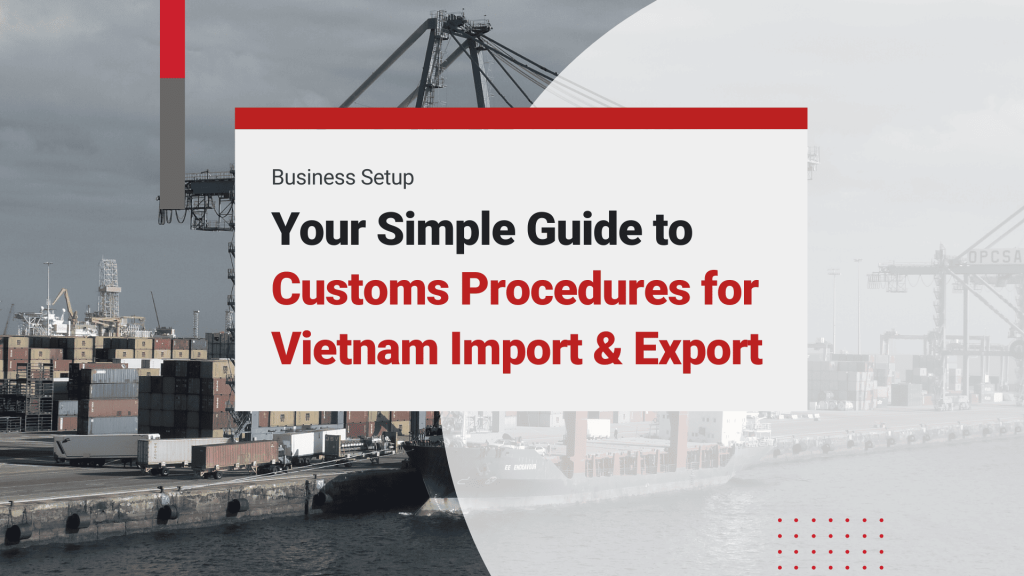Overview
When a foreign company wishes to export goods to Vietnam, it must follow both export procedures in the country of origin and import procedures in Vietnam. The process involves:
-
Signing a sales contract
-
Preparing commercial and shipping documents
-
Arranging international shipment
-
Completing Vietnam’s customs clearance procedures

Export Process to Vietnam
Step 1: Sign the Sales Contract
Both the exporter and the Vietnamese importer must sign a legally binding foreign trade contract that outlines:
-
Product specifications, quantity
-
Price terms (e.g., FOB, CIF — Incoterms 2020)
-
Payment method (e.g., T/T, L/C)
-
Delivery method and documentation required
Step 2: Prepare Export Documents
The foreign exporter is responsible for preparing the following documents:
| No. | Document Name | Purpose |
|---|---|---|
| 1 | Commercial Invoice | Details goods and transaction value |
| 2 | Packing List | Lists packaging and shipment breakdown |
| 3 | Bill of Lading / Airway Bill | Proof of shipment and delivery |
| 4 | Certificate of Origin (C/O) | For import duty reduction under FTAs (Form E, D, etc.) |
| 5 | Phytosanitary / Fumigation Certificate | Required for agricultural/timber goods |
| 6 | MSDS (if applicable) | Safety info for chemicals/dangerous goods |
Import Clearance in Vietnam
The Vietnamese importer will handle the customs clearance procedures upon cargo arrival at seaports (e.g., Cat Lai, Hai Phong) or airports (e.g., Noi Bai, Tan Son Nhat):
Step 1: Customs Declaration
-
Using Vietnam’s electronic customs system (VNACCS/VCIS) and others paper which help
-
Submit the full set of documents: Invoice, Packing List, C/O, B/L, Customs Declaration Form, etc.
Step 2: Customs Inspection & Risk Channeling
-
Green channel: Automatic clearance
-
Yellow channel: Document inspection
-
Red channel: Physical inspection of cargo
Step 3: Pay Import Duties & VAT
-
Import duty based on HS code
-
VAT (typically 10%, some goods 8%)
-
With valid Certificate of Origin, import tax may be reduced or exempted
Step 4: Cargo Release
After taxes are paid and customs clearance is granted, the importer can collect goods and proceed with domestic distribution.

Important Notes for Exporters
-
Check Vietnam’s list of prohibited or restricted imports (e.g., cosmetics, food supplements, waste materials may require extra licenses)
-
Always share scanned documents with your Vietnamese partner ahead of shipment
-
Work with a freight forwarder or customs broker in Vietnam to handle paperwork smoothly
- Thought this is just a better way to prove that foreign countries should have invested in many goods and product for Vietnam.
Step to export goods to Vietnam
1. Sign Contract
Agree on terms: product, Incoterms, price, delivery, payment.
2. Prepare Documents
Include:
-
Commercial Invoice
-
Packing List
-
Bill of Lading / Air Waybill
-
Certificate of Origin (Form D/E…)
-
Other certs (e.g., Health, Phytosanitary)
3. Arrange Shipment
Book with a trusted forwarder. Confirm schedule & port (e.g., Cat Lai, Hai Phong).
4. Send Pre-Alert
Email scanned docs to buyer for customs pre-check.
5. Customs Clearance in Vietnam
Buyer declares via e-system, pays duty/VAT, follows inspection process.
6. Delivery
Goods are released and transported to final destination.

